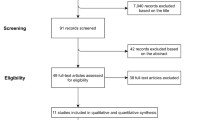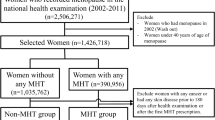Abstract
Objective
We aimed to examine whether use of hormone replacement therapy (HRT) and oral contraceptives (OC) affect the risk of basal cell carcinoma (BCC) and squamous cell carcinoma (SCC) in women.
Methods
Using data from 29,875 women enrolled in the prospective “Diet, Cancer, and Health” study between 1993 and 1997, women with available information on HRT and OC use at baseline were identified. Statistical analyses were based on the Cox’s proportional hazards model.
Results
The mean age at enrollment in the study was 56.7 years, whereas the mean age at the end of follow-up was 67.5 years. 1,175 cases of BCC and 76 cases of SCC were identified in the cohort during follow-up through 2007. The BCC incidence rate ratio was 1.15 (95% CI: 1.07–1.37) for ever users of HRT at baseline compared to never users, whereas risk of BCC was unaffected by duration of HRT use. Ever use of HRT was not associated with SCC risk but a significantly increased risk of 1.35 (95% CI: 1.05–1.72) associated with every 5 years of HRT use was observed. No convincing associations between OC use and BCC or SCC risk were observed.
Conclusion
The findings indicated that HRT but not OC may increase the risk of NMSC. However, further studies are warranted as risk estimates for SCC had relatively low precision due to a limited number of SCC cases.
Similar content being viewed by others
References
Brewster DH, Bhatti LA, Inglis JH, Nairn ER, Doherty VR (2007) Recent trends in incidence of nonmelanoma skin cancers in the East of Scotland, 1992–2003. Br J Dermatol 156:1295–1300
de VE, Louwman M, Bastiaens M, de GF, Coebergh JW (2004) Rapid and continuous increases in incidence rates of basal cell carcinoma in the southeast Netherlands since 1973. J Invest Dermatol 123:634–638
Diepgen TL, Mahler V (2002) The epidemiology of skin cancer. Br J Dermatol 146:1–6
Madan V, Lear JT, Szeimies RM (2010) Non-melanoma skin cancer. Lancet 375:673–685
Birch-Johansen F, Jensen A, Mortensen L, Olesen AB, Kjaer SK (2010) Trends in the incidence of nonmelanoma skin cancer in Denmark 1978–2007: rapid incidence increase among young Danish women. Int J Cancer 127:2190–2198
Harris RB, Griffith K, Moon TE (2001) Trends in the incidence of nonmelanoma skin cancers in southeastern Arizona, 1985–1996. J Am Acad Dermatol 45:528–536
Hayes RC, Leonfellner S, Pilgrim W, Liu J, Keeling DN (2007) Incidence of nonmelanoma skin cancer in New Brunswick, Canada, 1992 to 2001. J Cutan Med Surg 11:45–52
Bath-Hextall F, Leonardi-Bee J, Smith C, Meal A, Hubbard R (2007) Trends in incidence of skin basal cell carcinoma. Additional evidence from a UK primary care database study. Int J Cancer 121:2105–2108
Karagas MR, Greenberg ER, Spencer SK, Stukel TA, Mott LA (1999) Increase in incidence rates of basal cell and squamous cell skin cancer in New Hampshire, USA. New Hampshire Skin Cancer Study Group. Int J Cancer 81:555–559
Bielsa I, Soria X, Esteve M, Ferrandiz C (2009) Population-based incidence of basal cell carcinoma in a Spanish Mediterranean area. Br J Dermatol 161:1341–1346
Christenson LJ, Borrowman TA, Vachon CM et al (2005) Incidence of basal cell and squamous cell carcinomas in a population younger than 40 years. JAMA 294:681–690
Young C (2009) Solar ultraviolet radiation and skin cancer. Occup Med (Lond) 59:82–88
Koster B, Thorgaard C, Clemmensen IH, Philip A (2009) Sunbed use in the Danish population in 2007: a cross-sectional study. Prev Med 48:288–290
Nelson HD, Humphrey LL, Nygren P, Teutsch SM, Allan JD (2002) Postmenopausal hormone replacement therapy: scientific review. JAMA 288:872–881
Casey PM, Cerhan JR, Pruthi S (2008) Oral contraceptive use and risk of breast cancer. Mayo Clin Proc 83:86–90
La VC (2006) Oral contraceptives and ovarian cancer: an update, 1998–2004. Eur J Cancer Prev 15:117–124
Lens M, Bataille V (2008) Melanoma in relation to reproductive and hormonal factors in women: current review on controversial issues. Cancer Causes Control 19:437–442
Mackie RM, Hauschild A, Eggermont AM (2009) Epidemiology of invasive cutaneous melanoma. Ann Oncol 20:vi1–vi7
Gupta A, Driscoll MS (2010) Do hormones influence melanoma? Facts and controversies. Clin Dermatol 28:287–292
Grossman L, Wei Q (1995) DNA repair and epidemiology of basal cell carcinoma. Clin Chem 41:1854–1863
Welsh MM, Karagas MR, Applebaum KM, Spencer SK, Perry AE, Nelson HH (2008) A role for ultraviolet radiation immunosuppression in non-melanoma skin cancer as evidenced by gene-environment interactions. Carcinogenesis 29:1950–1954
Asgari MM, Efird JT, Warton EM, Friedman GD (2010) Potential risk factors for cutaneous squamous cell carcinoma include oral contraceptives: results of a nested case-control study. Int J Environ Res Public Health 7:427–442
Applebaum KM, Nelson HH, Zens MS, Stukel TA, Spencer SK, Karagas MR (2009) Oral contraceptives: a risk factor for squamous cell carcinoma? J Invest Dermatol 129:2760–2765
Vessey MP, Painter R, Powell J (2000) Skin disorders in relation to oral contraception and other factors, including age, social class, smoking and body mass index. Findings in a large cohort study. Br J Dermatol 143:815–820
Wei Q, Matanoski GM, Farmer ER, Hedayati MA, Grossman L (1994) DNA repair related to multiple skin cancers and drug use. Cancer Res 54:437–440
Tjonneland A, Overvad K, Haraldsdottir J, Bang S, Ewertz M, Jensen OM (1991) Validation of a semiquantitative food frequency questionnaire developed in Denmark. Int J Epidemiol 20:906–912
Overvad K, Tjonneland A, Haraldsdottir J, Ewertz M, Jensen OM (1991) Development of a semiquantitative food frequency questionnaire to assess food, energy and nutrient intake in Denmark. Int J Epidemiol 20:900–905
National Board of Health (2009) National Board of Health, The Danish Cancer Registry 2008 [in Danish]. National Board of Health, Copenhagen. Available at http://www.sst.dk/Udgivelser/2009/Cancerregisteret%202008.aspx. Accessed 28 Jan 2011
The Danish Registry of Pathology 2008 [in Danish]. Available at http://www.patobank.dk/. Accessed 28 Jan 2011
Lamberg AL, Cronin-Fenton D, Olesen AB (2010) Registration in the Danish regional nonmelanoma skin cancer dermatology database: completeness of registration and accuracy of key variables. Clin Epidemiol 2:123–136
Greenland S (1995) Dose-response and trend analysis in epidemiology: alternatives to categorical analysis. Epidemiology 6:356–365
Fung TT, Hunter DJ, Spiegelman D, Colditz GA, Rimm EB, Willet WC (2002) Intake of alcohol and alcoholic beverages and the risk of basal cell carcinoma of the skin. Cancer Epidemiol Biomarkers Prev 11:1119–1122
Freedman DM, Sigurdson A, Doody MM, Mabuchi K, Linet MS (2003) Risk of basal cell carcinoma in relation to alcohol intake and smoking. Cancer Epidemiol Biomarkers Prev 12:1540–1543
McLoone NM, Middleton RJ, Gavin AT, Walsh M, Dolan OM (2003) Audit of basal cell carcinoma: registration practice. Br J Dermatol 148:371
Cooper SM, George S (2001) Photosensitivity reaction associated with use of the combined oral contraceptive. Br J Dermatol 144:641–642
Silver EA, Silver AH, Silver DS, McCalmont TH (2003) Pseudoporphyria induced by oral contraceptive pills. Arch Dermatol 139:227–228
Sedee A, van Beijersbergen HG (1985) Photosensitized decomposition of contraceptive steroids: a possible explanation for the observed (photo)allergy of the oral contraceptive pill. Arch Pharm (Weinheim) 318:111–119
Wei Q, Matanoski GM, Farmer ER, Hedayati MA, Grossman L (1994) DNA repair and susceptibility to basal cell carcinoma: a case-control study. Am J Epidemiol 140:598–607
Thornton MJ (2002) The biological actions of estrogens on skin. Exp Dermatol 11:487–502
Thiele JJ, Gilchrest BA (2008) Aging skin. In: Nouri K (ed) Skin cancer. McGraw-Hill Professional, New York, NY pp 17–31
Munoz N, Castellsague X, de Gonzalez AB, Gissmann L (2006) Chapter 1: HPV in the etiology of human cancer. Vaccine 24:1–10
Nindl I, Gottschling M, Stockfleth E (2007) Human papillomaviruses and non-melanoma skin cancer: basic virology and clinical manifestations. Dis Markers 23:247–259
Armstrong BK, Kricker A (2001) The epidemiology of UV induced skin cancer. J Photochem Photobiol B 63:8–18
Lock-Andersen J, Drzewiecki KT, Wulf HC (1999) Naevi as a risk factor for basal cell carcinoma in Caucasians: a Danish case-control study. Acta Derm Venereol 79:314–319
Author information
Authors and Affiliations
Corresponding author
Rights and permissions
About this article
Cite this article
Birch-Johansen, F., Jensen, A., Olesen, A.B. et al. Does hormone replacement therapy and use of oral contraceptives increase the risk of non-melanoma skin cancer?. Cancer Causes Control 23, 379–388 (2012). https://doi.org/10.1007/s10552-011-9887-4
Received:
Accepted:
Published:
Issue Date:
DOI: https://doi.org/10.1007/s10552-011-9887-4




